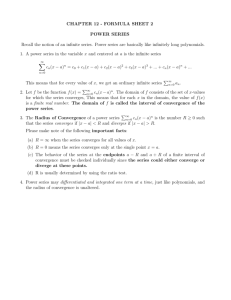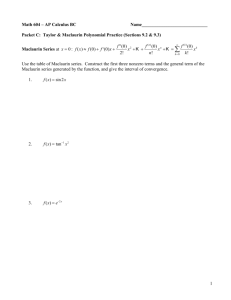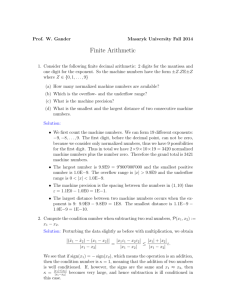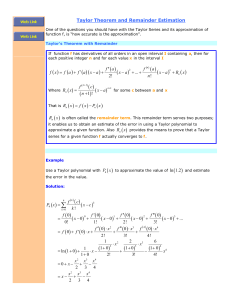lecture notes week 8, lectures 19 to 21
advertisement
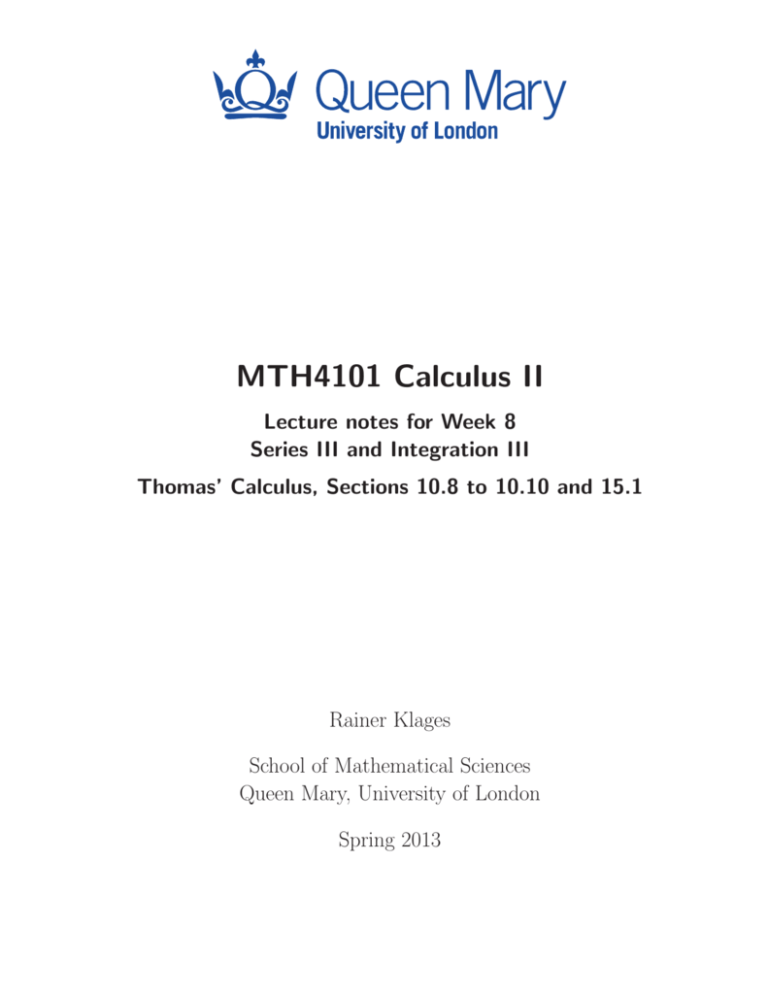
MTH4101 Calculus II Lecture notes for Week 8 Series III and Integration III Thomas’ Calculus, Sections 10.8 to 10.10 and 15.1 Rainer Klages School of Mathematical Sciences Queen Mary, University of London Spring 2013 Taylor and Maclaurin Series Assume that the function f (x) can be represented as a power series f (x) = ∞ X n=0 an (x − a)n = a0 + a1 (x − a) + · · · + an (x − a)n + · · · and converges for a − R < x < a + R with R > 0. Can we calculate the coefficients an in terms of f (x)? It can be shown1 that f (x) has derivatives of all orders inside this interval by differentiating the power series term by term: f ′ (x) = a1 + 2a2 (x − a) + · · · + nan (x − a)n−1 + · · · f ′′ (x) = 1 · 2a2 + 2 · 3a3 (x − a) + · · · + n(n − 1)an (x − a)n−2 + · · · .. . (n) f (x) = n! an + a sum of terms with (x − a) as a factor. Therefore f ′ (a) = a1 , f ′′ (a) = 1 · 2a2 , f ′′′ (a) = 1 · 2 · 3a3 , . . . , f (n) (a) = n! an . This gives us a formula for the coefficients in the power series: f (n) (a) . n! It also suggest that if f has a power series representation then it must be an = f (x) = f (a) + f ′ (a)(x − a) + f ′′ (a) f (n) (a) (x − a)2 + · · · + (x − a)n + · · · . 2! n! leading us to the following definition: 1 This is a theorem, which can be proved. Likewise, it can be proved that f (x) can be integrated term by term; see Thomas’ Calculus, end of Section 10.7. for details. 3 Example: Find the Taylor series generated by f (x) = 1/x at x = 2. Where, if anywhere, does the series converge to 1/x? 1 2 f (x) = x−1 ; f (2) = 2−1 = f ′ (x) = −x−2 ; f ′ (2) = − f ′′ (x) = 2! x−3 ; f ′′ (2) 1 = 2−3 = 3 2! 2 .. . f (n) (x) = (−1)n n! x−(n+1) ; 1 22 (−1)n f (n) (2) = n+1 . n! 2 The Taylor series is f (2) + f ′ (2)(x − 2) + f (n) (2) f ′′ (2) (x − 2)2 + · · · + (x − 2)n + · · · . 2! n! This is a geometric series with first term 1/2 and ratio r = −(x − 2)/2. It converges absolutely for |x − 2| < 2, or 0 < x < 4 with sum S= 1/2 1 1 = = . 1 + (x − 2)/2 2 + (x − 2) x Related to the Taylor series is the Taylor polynomial of order n: There is a similar definition for Maclaurin polynomials. Example: Find the Taylor polynomials of order 0, 2 and 4 for the function f (x) = cos x at x = 0. We have f (x) = cos x , f ′ (x) = − sin x , f ′′ (x) = − cos x , f ′′′ (x) = sin x , f (4) (x) = cos x and f (0) = 1, f ′ (0) = 0, f ′′ (0) = −1, f ′′′ (0) = 0, f (4) (0) = 1 . 4 By using the previous definition, the first three Taylor polynomials of f (x) = cos x about x = 0 are P0 (x) = 1 x2 P2 (x) = 1 − 2! x2 x4 P4 (x) = 1 − + . 2! 4! The following figure shows how successive Taylor polynomials provide better and better approximations to the function as n → ∞: Below we give the Taylor series expansions for a variety of functions about x = 0 and x = 1. These can all be derived using the methods in this section. Taylor series about x = 0: x2 x3 x4 + + + ··· 2! 3! 4! x3 x5 x7 x− + − + ··· 3! 5! 7! x2 x4 x6 1− + − + ··· 2! 4! 6! x2 x4 x6 1+ + + + ··· 2! 4! 6! x3 x5 x7 x+ + + + ··· . 3! 5! 7! ex = 1 + x + sin x = cos x = cosh x = sinh x = Taylor series about x = 1: 1 1 1 ln x = (x − 1) − (x − 1)2 + (x − 1)3 − (x − 1)4 + · · · 2 3 4 √ 1 1 1 x = 1 + (x − 1) − (x − 1)2 + (x − 1)3 − · · · . 2 8 16 5 Convergence of Taylor Series and Error Estimates There are still two unanswered questions about Taylor series: 1. When does a Taylor series converge to the function that generated it? 2. How accurately do a function’s Taylor polynomials approximate the function on a given interval? To answer these questions we need to make use of Taylor’s formula: This theorem can be understood as a generalization of the Mean Value Theorem (set n = 0 in the above formula). The quantity Rn (x) in Taylor’s Formula is called the remainder of order n or the error term for the approximation of f by Pn (x) over I. If Rn (x) → 0 as n → ∞ for all x ∈ I, we say that the Taylor series converges to f on I and we write f (x) = ∞ X f (k) (a) k=0 k! (x − a)k . Finally we can use the Remainder Estimation Theorem to provide an estimate of the error: 6 The usefulness of this theorem is demonstrated by the following example: Example: Show that the Taylor series for sin x at x = 0 converges for all x. We have f (x) = sin x , f ′ (x) = cos x , f ′′ (x) = − sin x , . . . and, in general, f (2k) (x) = (−1)k sin x , f (2k+1) (x) = (−1)k cos x Therefore, evaluating at x = 0 gives f (2k) (0) = 0 and f (2k+1) (0) = (−1)k . Hence the Taylor series for sin x at x = 0 is x3 x5 (−1)k x2k+1 sin x = x − + − ··· + + R2k+1 (x) . 3! 5! (2k + 1)! Applying the Remainder Estimation Theorem with M = 1 gives |R2k+1 (x)| ≤ 1 · |x|2k+2 → 0 as k → ∞ for all x. (2k + 2)! (cf. the list of sequences and their limits discussed in Week 5) Therefore R2k+1 (x) → 0 and the Maclaurin series for sin x converges to sin x for every x. Applications of Power Series Binomial series The Taylor series generated by f (x) = (1 + x)m (around x = 0) where m is a constant is m(m − 1) 2 m(m − 1)(m − 2) 3 x + x + ··· 2! 3! m(m − 1)(m − 2) . . . (m − k + 1) k x + ··· . + k! f (x) = 1 + mx + This is called the binomial series. If m ≥ 0 is an integer, the series stops after (m+1) terms because coefficients from k = m+1 onwards are zero. If m is not a positive integer the series is infinite. From the Ratio Test for absolute convergence it follows that this series converges absolutely for |x| < 1. It can also be shown that the series converges to (1 + x)m . We can define this series conveniently as follows: 7 Note that m ∈ R. In the case of m ∈ N we recover the familiar binomial coefficients. Note also the relation between the binomial series and the binomial formula. In the case where m = −1, −1 −1 −1 = (−1)k . = 1 and = −1 , k 2 1 For example, x = x(1 + x2 )−1 2 1+x (−1)(−2) 4 (−1)(−2)(−3) 6 2 = x 1−x + x + x + ··· 2! 3! = x(1 − x2 + x4 − x6 + · · · ) = x − x3 + x5 − x7 + · · · which is a geometric series. Reading assignment: Work yourself through the following two examples. (cf. Examples 3 and 7 in Thomas’ Calculus, Section 10.10) Evaluation of non-elementary integrals We can use the term-by-term integration property of power series to allow us to do nonelementary integrals. Example: R Express sin x2 dx as a power series. Recall that x3 x5 + − ··· sin x = x − 3! 5! 8 Hence sin x2 = x2 − and so Z sin x2 dx = C + where C is a constant of integration. x6 x10 + − ··· 3! 5! x7 x11 x3 − + − ··· . 3 7 · 3! 11 · 5! Evaluating indeterminate forms Power series also provide an alternative to L’Hôpital’s rule for evaluating indeterminate forms. Example: Find lim x→0 1 1 − sin x x . We can write x− x− Hence x3 3! + x5 5! − ··· − ··· 1 x − sin x 1 − = = 3 5 sin x x x sin x x · x − x3! + x5! 2 1 x2 x3 3!1 − x5! + · · · − + · · · 3! 5! =x . = 2 2 x x 1 − 3! + · · · x2 1 − 3! + · · · lim x→0 1 1 − sin x x = lim x x→0 1 3! − 1− x2 5! x2 3! + ··· + ··· = 0. Note that since 1/ sin x − 1/x ≈ x · (1/3!) = x/6, we can write cosec x ≈ (1/x) + (x/6). Double Integrals Consider a function f (x, y) defined on a rectangular region R : a ≤ x ≤ b, c ≤ y ≤ d partitioned into small rectangles Ak : 9 The area of a small rectangle with sides ∆xk and ∆yk is ∆Ak = ∆xk ∆yk . Choose a point (xk , yk ) in the (suitably numbered) kth rectangle with function value f (xk , yk ). We can consider z = f (x, y) as defining the height z at the point (x, y). The product f (xk , yk ) ∆Ak is then the volume of a solid with base area ∆Ak and height f (xk , yk ) (for which we assume that f (xk , yk ) > 0): The Riemann sum Sn of these solids over R is Sn = n X f (xk , yk ) ∆Ak . k=1 Now consider what happens as ∆Ak → 0 (as n → ∞), i.e., we refine the partitioning. When the limit of these sums exists the function f is said to be integrable and the limit is called the double integral of f over R, written as Z Z Z Z f (x, y) dA or f (x, y) dx dy R R The volume of the portion of the solid directly above the base ∆Ak is f (xk , yk ) ∆Ak . Hence the total volume above the region R is Z Z Volume = lim Sn = f (x, y) dA n→∞ R where ∆Ak → 0 as n → ∞. The following figure shows how the Riemann sum approximations of the volume become more accurate as the number n of boxes increases: 10
